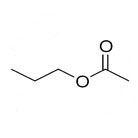What is N-Propyl Acetate?
Normal propyl acetate (also known as n-propyl acetate, 1-propyl acetate, propyl acetate, 1-acetoxypropane, acetic acid) is an organic compound with a molecular formula of C5H10O2 / CH3COOCH2CH2CH3. It is a clear, colourless ester that has a distinguishable acetate odour, is highly flammable, highly miscible with all common organic solvents (alcohols, ketones, glycols, esters) but only slightly miscible in water.

Technical Properties
Chemical and physical properties of n-propyl acetate:
Molecular Formula: C5H10O2 / CH3COOCH2CH2CH3
Synonyms: n-propyl acetate, 1-propyl acetate, propyl acetate, npac, npa, np, normal propyl acetate, propyl ethanoate, n-propyl ethanoate, propyl ester, acetic acid, n-propyl ester, 1-acetoxypropane.
Cas Number: 109-60-4
Molecular Mass: 102.06808 g/mol
Flashpoint: 58 °F / 14.4 °C
Boiling Point: 214.9 ° F at 760 mm Hg
Melting Point: -139 °F / -95 °C
Vapour Pressure: 67.21 mm Hg
Water Solubility: g/100ml at 16 °C: 1.6
Density: 0.886 at 68 °F
How is it produced?
The primary and most common method for chemically manufacturing n-propyl acetate is the direct esterification of 1-propanol and acetic acid which are heated in the presence of a strong acid, such as sulfuric or methanesulfonic acid. An alternate method involves the ester interchange of 1-propanol with ethyl acetate.
Handling, storage and distribution
Hazards and safety
N-propyl acetate has an NFPA health rating of 1, indicating that it can irritate extensive exposure. An NFPA fire rating of 3 demonstrates that it is highly flammable and can be easily ignited by heat or sparks under ambient conditions. Its vapours travel to the source of the ignition and are heavier than air. In the case of a fire, use dry chemical, CO2 or alcohol-resistant foam. An NFPA instability rating of 0 shows that butyl tri glycol is stable underneath most conditions, including fire.
Full personal protective equipment should be worn when handling n-propyl acetate to prevent contact with the skin, eyes and mouth.
Storage and distribution
A chemical wholesaler would have a bulk petrochemical storage facility to regulate this product. Storage is normally in a cool, dry and well ventilated facility away from oxidising agents. Normal propyl acetate should be kept out of direct sunlight, heat and open flames. Solvents such as normal propyl acetate should be stored in drummed containers such as isotanks made of stainless steel, aluminium or carbon steel.
A bulk chemical exporter would normally distribute this solvent in bulk vessels or tank trucks. For transportation purposes, normal propyl acetate is classed as a flammable liquid with a fire hazard rating of 2. A full bulk chemical distributor would export the solvent throughout regions such as the UK, Europe, Africa and America. This product is a packing group 2.
What is N-Propyl Acetate used for?
The major use of normal propyl acetate is as a solvent in the coatings and printing industries. It is a good solvent for these industries because it has the ability to thin many other organic compounds. Normal propyl acetate dissolves a host of resins which make it a suitable solvent for wood lacquers and industrial finishes. Within the printing industry it is mainly used in flexographic and special screening prints. It is also used in aerosol sprays, nail care and as a fragrance solvent. It can also be used as a flavouring additive due to its odour similar to pears. The main user end markets are the printing, coatings, lacquers, cosmetic and flavouring industries.



